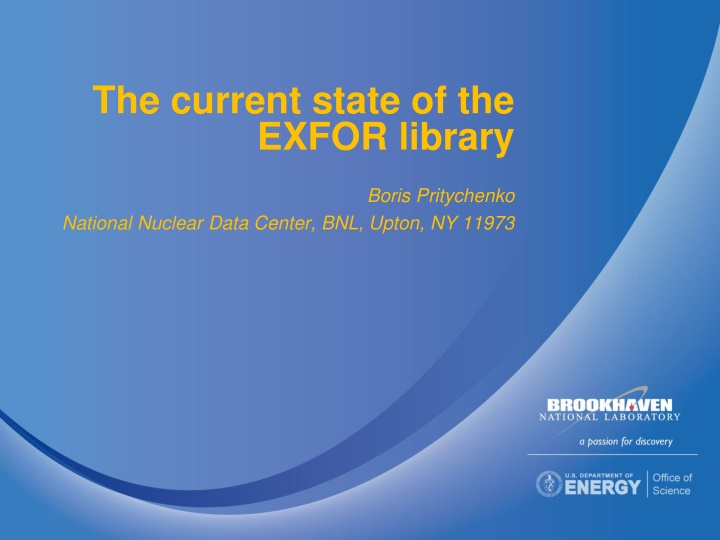
Insights into the Current State of the EXFOR Library and Data Recovery Efforts
Explore the operations of the EXFOR library at the Boris Pritychenko National Nuclear Data Center, including the FY2014 compilations, challenges with missing data, and the Oak Ridge Data Recovery Effort. Learn about the types of missing data and the collaborative efforts to enhance the EXFOR database with new compilations and data recovery initiatives.
Download Presentation

Please find below an Image/Link to download the presentation.
The content on the website is provided AS IS for your information and personal use only. It may not be sold, licensed, or shared on other websites without obtaining consent from the author. If you encounter any issues during the download, it is possible that the publisher has removed the file from their server.
You are allowed to download the files provided on this website for personal or commercial use, subject to the condition that they are used lawfully. All files are the property of their respective owners.
The content on the website is provided AS IS for your information and personal use only. It may not be sold, licensed, or shared on other websites without obtaining consent from the author.
E N D
Presentation Transcript
The current state of the EXFOR library Boris Pritychenko National Nuclear Data Center, BNL, Upton, NY 11973
Introduction 2014 NNDC Operation Collective effort (B. Pritychenko, S. Hlavac and O. Schwerer) Submission of EXFOR entries to prelims, quality control, final data transmissions by the IAEA. 12 database updates. Web Interface upgrade by V. Zerkin.
FY2014 EXFOR Compilations EXFOR compilation workflow ~6-8 months. Accession numbers for new compilations in 2014: Neutron: 29 Charged Particles: 66 Photons: 11 New compilations (https://www-nds.iaea.org/exfor- master/x4compil/exfor_input.htm): 75 in 2010 Calendar Year. 78 in 2011 Calendar Year. 128 in 2012 Calendar Year. 121 in 2013 Calendar Year. 79+3=82 in 2014 Calendar Year as of April 15, 2015; more in preliminary transmissions. Recompilation of existing, problematic entries.
Missing Data in EXFOR First, I learned about missing data when Viktor s Web Interface refused to produce any plotted data. Second, I have heard complaints of F. Kaeppeler, who advised me to compare EXFOR and CINDA. Third, as an EXFOR manager I got more familiar with the issue that was caused by multiple reasons Historical reasons EXFOR compilation scope evolution Lack of technical tools and resources in the past Lack of motivation among EXFOR compilers ..
Types of Missing Data Completely missing publications Charged particles, proton beams are most easily available while proton-induced reactions are only 19.8% of EXFOR, vs. 48.8% for neutrons ??? Photonuclear is only 5.74% of EXFOR ??? A small number of neutron papers is still missing Existing experimental publications Experimentalists would not always share data, compilers proactively will create empty subentries - UNOBT status (5-10%) - Missing without UNOBT status (<5%) Compilers fail to create subentries for the existing data because compiler always had a choice during the compilation, i.e. compile resonance parameters but not Maxwellian cross section. Non existing data sets because compilers proactively will make up subentries.
Oak Ridge Data Recovery Effort NRDC 2014 action A36: Establish a mechanism with ORNL to receive the time-of- flight spectra (transmission and reaction yield) measured at ORELA for inclusion to EXFOR. NNDC/ORNL, many thanks to K. Guber: F, Al, Si, Cl, Ti, Fe, Mn, Cr, Ni, K, Sn, Nd and U capture, transmission and fission data sets. Data of J. Harvey and R. Spencer. Data were recovered from DVDs made in 2007; we could not read one of them. The defective DVD will be further evaluated by NNDC because data there are worth millions and millions of dollars!!! Entry 13647: 142,144Nd data from ORELA. Many corrections are necessary, no UNOBT. NRDC 2015 action: Compile TOF spectra newly received from ORELA in 2015.
UNOBT for CIELO Project NRDC 2014 action A 56: Try to add numerical data which are not superseded (SPSDD) but still unobtainable (UNOBT) for neutron- induced reaction data published in old literature for 1H, 16O, 56Fe, 235U, 238U and 239Pu. NNDC has considered it as a broader mandate and fixed the following H,C,O,Fe,235,238U, 239Pu neutron- and proton-induced reactions unobt data sets Work on unobt continues, current state on the Web - 192 neutron-induced reactions (225 datasets) in area #1 => 136 reactions (151 datasets) - 391 all reactions (444 datasets) in area #1 => 280 reactions (312 datasets) Action A 56 is completed.
Missing Photonuclear Publications Missing experiments search Find a single missing paper and trace author using NSR web Interface. NSR displays EXFOR links when we have a match. Using this method plenty of data from University of Virginia, Iowa State University electron synchrotrons were discovered, and University of Illinois betatron. We had more experimental facilities in the past!!! This approach is universal, could be used to search for missing neutron and charged particle data.
Research Evolution in Area #1 The largest number of X4 experiments was in the 70ies. The overall number of nuclear reaction measurements in the area 1 is 37.16%, area 2 is 34.79%, area 3 is 13.35% and area 4 is 14.70% of the total. Hopefully, the LANSCE accelerator upgrade and full implementation of FRIB project will further increase an output for the area 1.
Conclusions EXFOR compilation effort is complex and well-organized. We address compilation of current articles, correct previous entries and add missing articles. EXFOR database is incomplete due to multiple historical and technological reasons. We should continue to work on compilation of missing articles, correct previous entries. The work on UNOBT Area #1 entries for CIELO project needs is done. It is a team effort that is conducted in close cooperation with the IAEA.
